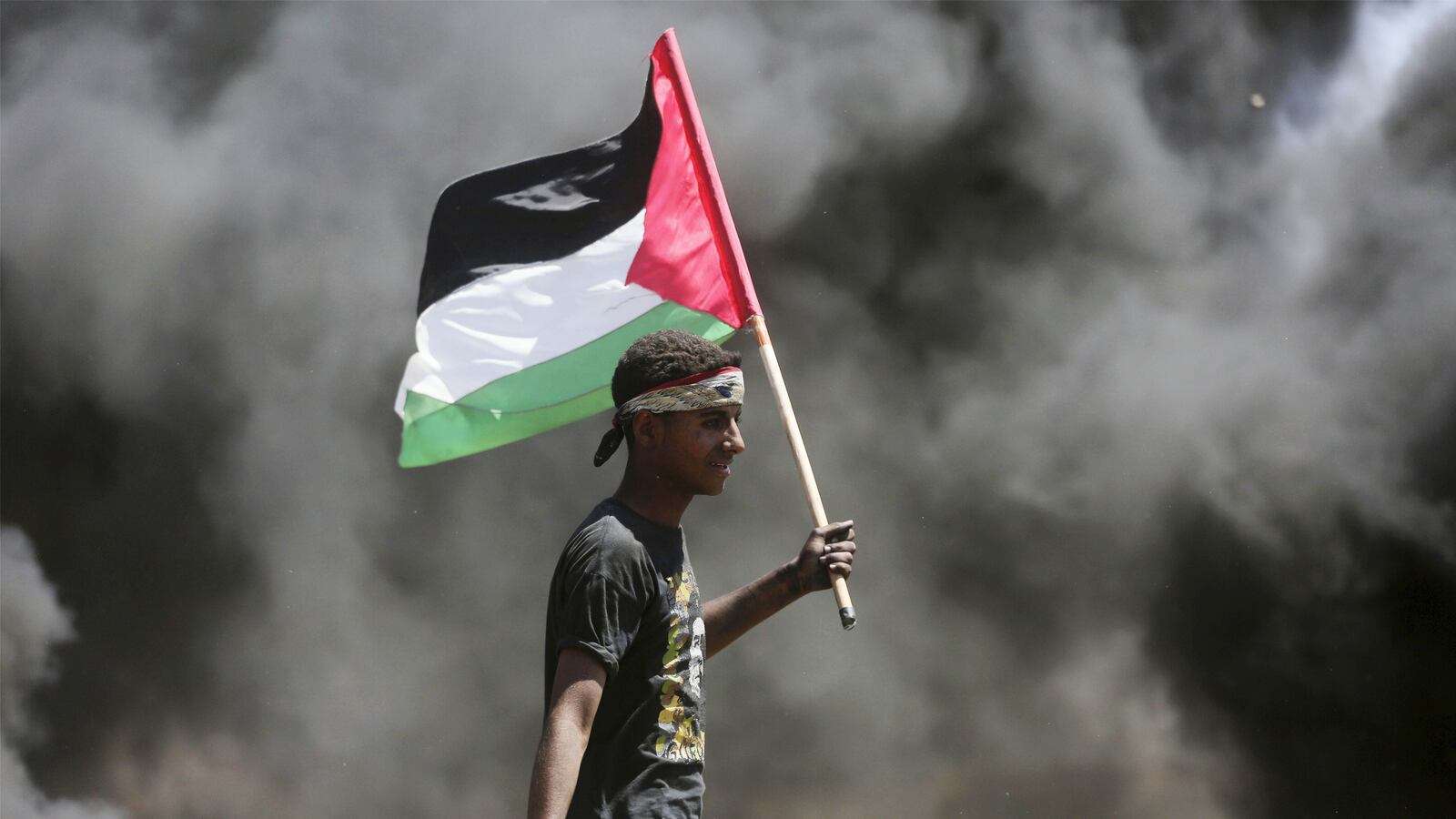KISSUFIM, Israel—From a hill outside this southern Israeli village, farmland stretches out below until it hits a small forest. Right beyond that is the Gaza Strip. Rising above the forest is a mountain, located near the Gazan city of Deir al-Balah. The clear blue of the Mediterranean Sea sneaks a peak just behind. Yet there are no mountains in Gaza; it is an almost wholly flat piece of coastal plain boxed in on all four sides by Israel, Egypt, and the Med. The mountain is a trash dump—white, brown, yellow and grey, with seagulls circling—that dominates everything else in central Gaza.
Bloody confrontations between Palestinian demonstrators and the Israel Defense Forces (IDF) on and around the border fence have claimed the lives of more than 100 Gazans over the last seven weeks, 60 just yesterday. That trash mountain explains a lot about how we got to the current moment: with thousands of Gazans willing to risk harm—if not death—in an attempt to breach the fence and infiltrate into Israel.
Gaza’s tragic descent into a place that the United Nations has deemed will be unlivable in just two year’s time began in 2005 with the removal of all Israeli settlers and soldiers from the coastal territory, occupied by Egypt until the 1967 war. The territory was handed over to the Palestinian Authority (PA) which was then, two years later, violently overthrown by Hamas. The Islamist group has ruled Gaza ever since with, as one former Palestinian official put it to me, “steel and fire.” As an internationally designated terror group, Hamas was faced with an old choice: they could recognize Israel, adhere to prior Israeli-Palestinian peace agreements, and renounce violence, or not. Predictably, they refused.
Yet even after the Hamas coup, most of Gaza’s border crossings were still operational, albeit on a limited basis. The initial curtailment came in 2006 after a Hamas cross-border raid that managed to kidnap an IDF sergeant. He was later swapped for over 1,000 Palestinian militants held in Israeli prisons. The real change occurred between 2008 and 2010, where many of the crossings were attacked by Gaza-based militants with mortars, truck bombs and, on one occasion, explosive-laden horses.
Israel responded with a blockade of the territory, leaving one main crossing open for goods, fuel and the like, and another crossing open for the movement of people. The Rafah crossing connecting Gaza with Egypt was itself only sporadically opened for people.
Nevertheless, life persisted—and for some even flourished—in the coastal enclave, primarily due to the extensive underground tunnel network connecting Gaza with Egypt’s Sinai Peninsula. At its height, there were over a thousand of these tunnels, bringing in everything from military hardware, rockets, fuel for automobiles, construction material, and daily consumer goods (including, in one famous instance, a Kentucky Fried Chicken order). By one estimate, two-thirds of all trade into Gaza at that time went through the tunnels, and Hamas enriched its own coffers by taxing it. An entire class of Gazan nouveau riche—many tied to Hamas and the tunnel economy—sprang up, with reports even of luxury sports cars on the streets of Gaza City.
All this began to change with the overthrow of the Muslim Brotherhood government in Cairo in 2013 and the installation of a new military regime led by General Abdel Fattah al-Sisi. An avowed opponent of the Muslim Brotherhood, of which Hamas was an offshoot, Sisi began cracking down on the tunnel trade, sparking a major social and economic crisis inside Gaza.
Hamas responded in 2014 by, first, entering into a reconciliation agreement with its hated rivals in the Palestinian Authority (PA), led by the secular Fatah movement. Sheikh Hassan Youssef, a senior Hamas leader in the West Bank, readily admitted to me at the time that governance had taken a toll on Hamas; it wanted the PA to return and assume civilian responsibilities over the territory. “The sovereign loses,” he said. “We tell [PA President Mahmoud Abbas] ‘take.’ Hamas is [now] responsible for nothing.”
The complex reconciliation deal between Hamas and Fatah was already teetering for a variety of political reasons, but the death knell came in the summer of 2014 when a Hamas cell in the West Bank kidnapped and murdered three Israeli teenagers. It was, many observed then, a perfect way to scuttle a deal that many hardliners in Hamas had viewed with alarm. The alternative for them was military escalation, which in short order materialized: to try and wring from Israel, Egypt and the PA via armed conflict what Hamas couldn’t—or wouldn’t—agree to via negotiations.
The July-August war between Israel and Hamas that year was itself a turning point. After nearly two months and the loss of 2,000 Palestinian lives, the ceasefire agreement that was reached neither broke “the siege” of Gaza, as Hamas had demanded, nor forced the PA into significant economic concessions.
Instead, under U.N. auspices, the PA was called once more to take back civilian control over Gaza, as the only legitimate (non-terrorist) entity that Israel and the West would be willing to work with. For its part, the post-war period saw a major shift in Israeli policy. One Israeli military official I spoke to before the war had warned that Gaza was a “ticking bomb” that would explode in Israel’s face. Now, after the fighting, there was at least some buy-in from Israeli politicians to take steps it previously hadn’t countenanced, predicated on a basic wager: Palestinian reconciliation as a precondition for postwar reconstruction.
Yet Hamas and Fatah, once again, failed to deliver—instead choosing to embark on a mulit-year blame game over who was responsible for Gaza’s plight. Nevertheless, a highly complex U.N. program—called the Gaza Reconstruction Mechanism (GRM)—was instituted, which allowed cement to flow in and, under PA coordination and international supervision, begin rebuilding the devastated Strip. Foreign donors, too—in particular Qatar and Turkey—sent in money, although only a fraction of the billions of dollars in promised aid materialized. By one official count, though, since late 2014 over 120,000 homes in Gaza have been repaired, an additional 20,000 were rebuilt, and 1,000 international projects were ongoing.
The next few years were, in reality, some of the calmest Gaza and southern Israel had known—indeed, according to IDF officers responsible for the area, the quietest since 1967, if not 1948 and Israel’s founding. Few rockets were fired at Israel, and not only that, Hamas deployed its own border security force to track down renegade Salafist groups who did stray. And yet, under the surface—sometimes literally with its massive offensive tunnel project—Hamas was preparing, rearming and rebuilding. If, according to one senior Israeli military official I recently spoke to, the first two years after the 2014 war saw “an expansion and opening” in terms of Israeli policy vis-à-vis Gaza, then these middle years (2016-2017) were a time of “constriction.”
As the invaluable Israel-based NGO Gisha has pointed out tirelessly, the Israeli security establishment had rolled back many of the measures coming out of the 2014 war, in particular exports, the provision of exit permits (merchants, students, worshippers), and the import of some items deemed dual military-use. According to the senior military officer, Hamas even went so far as to forge medical records for alleged cancer patients so as to enter Israel. “When we ‘release’ Gaza then Hamas takes advantage,” he said, “it’s not a hobby here to stop items [from going in], it’s a security risk.”
Compounding matters, the Sisi government also showed no signs of relenting on its policy, keeping the Rafah crossing for the most part closed in an attempt to sever the ties between Hamas and the Islamic State insurgency causing Egypt so much pain in the Sinai Peninsula. This eventually came to pass, with Hamas taking the unprecedented step of razing a wide buffer zone on its side of the Gaza-Egypt border in a show of cracking down on the remaining smuggling trade—yet Rafah remained closed.
The coup de grace, though, came in April 2017 and was delivered by PA President Abbas. Nearing the tenth anniversary of the Hamas coup, and after a decade spending nearly half the PA budget subsidizing the Strip, Abbas reversed course: among cuts were long-standing subsidies for diesel fuel (for Gaza’s sole power plant), medicine and medical bills (for patients inside Israel) and, eventually, salaries to PA-affiliated civil servants who had been ordered to stay home after the Hamas takeover.
Gaza was both literally and figuratively thrown into darkness. Electricity in the sweltering summer plummeted to a mere three hours a day, drawing demonstrators to—indicatively—the border region. Lingering problems only worsened: Unemployment over 40 percent, youth unemployment more than 60 percent, two thirds of the population on some form of food or humanitarian aid, and clean water and sanitation systems on the verge of collapse.
Israeli security officials warned—again—of an impending humanitarian crisis, but the PA in Ramallah on the West Bank, as in previous years, appeared unmoved. As one Palestinian official told me in 2014 with a certain amount of glee, Hamas was “cornered…in the triangle of Gaza and drowning.”
By last fall, Hamas was at yet another crisis point, and looking—once more—for an exit. With Egyptian urging, it again entered into a reconciliation agreement with the PA, meant to remove the yoke of governing Gaza. As happened with Hassan Youssef three years prior, Yahya Sinwar, the new Hamas chief in Gaza, conceded that his movement had failed to govern. “This decision is a strategic one and there is no going back. Hamas will be completely out of the picture,” he said.
Except that Hamas was unwilling to lay down its arms, which for Abbas was a non-starter. “Abbas went to the mosque to pray,” a former PA intelligence chief once told me, “but he found the door closed.” The door, in this allegorical flourish, was Hamas—and its military wing. Never mind that behind that closed door were 2 million of his own desperate citizens. In private discussions, some Palestinian officials express frustration at this lack of empathy and compassion, but Abbas’s writ is unchallengeable.
By early this year, Palestinian reconciliation was, as the senior Israeli military official told me, “a body on life support.” Hamas, despite its best efforts, still had civil control over Gaza. Israel, for its part, had begun a third shift in policy since 2014, once again increasing access and movement to and from Gaza—but it was too little, too late. Not willing to solve Israel and the Palestinians’ problem for them, Egypt kept Rafah closed. The fear in Cairo, according to one foreign diplomat in Tel Aviv familiar with Egyptian thinking, was that thousands of “Gazan refugees would flood into Sinai.”
And then, of course, there is Hamas. Putting the Gazan people through another war—after three in the last nine years—was difficult to countenance. Abbas was playing a cynical game of power politics and appeared unmoved. The current Israeli government was unwilling to countenance taking serious steps—a port, a lifting of the blockade, a long-term truce—without reciprocal meaningful steps by Hamas (i.e. demilitarization). And the international community, to say nothing of the wider Arab world, had more pressing concerns.
So the Islamist movement latched on to a grassroots protest movement, the brainchild of one young man on Facebook, and eventually coopted it; sending thousands of Gazans—many unarmed civilians—to run at the Middle East’s most powerful army in the hope that someone pressures the PA, Israel, and Egypt to save it from its own rule.
The responsibility for this tragedy can be spread around among all the parties, but it remains, still, a tragedy—growing by the day, just like a mountain of trash overlooking the Mediterranean, with no end in sight.






